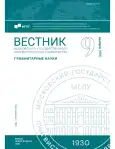The Phenomenon of Mirroring in Edogawa Rampo’s Short Story “The Twins”
- 作者: Chernova I.V.1, Semina I.A.1
-
隶属关系:
- Moscow State Linguistic University
- 期: 编号 9(903) (2025)
- 页面: 124-131
- 栏目: Literary criticism
- URL: https://journal-vniispk.ru/2542-2197/article/view/342330
- ID: 342330
如何引用文章
全文:
详细
The aim of this study is to examine the distinctive features of mirroring in Edogawa Rampo’s story as a multi-layered literary phenomenon that integrates psychological, philosophical, and cultural dimensions. The study explores the semantics of the mirror within the structure, where it functions as a symbolic object connecting the plot with traditional Japanese conceptions; as an instrument of the protagonist’s identity crisis, wherein his reflection becomes a projection of the “Shadow” (C.G. Jung) and a fragmented “Self” (J. Lacan); as a metaphor for confessional discourse, where the formal death-row confession devolves into a simulacrum of repentance (J. Baudrillard). Special attention is given to Rampo’s transformation of doppelgänger archetypes through modernist aesthetics, creating a synthesis of Japanese cultural tradition and Western psychological theories. The conclusion posits that “mirroring” in the story serves not only as a plot-forming device but also as a universal mechanism for representing existential crisis.
作者简介
Iuliia Chernova
Moscow State Linguistic University
编辑信件的主要联系方式.
Email: iu.v.chernova@linguanet.ru
PhD in Philology, Associate Professor, Head of the Department of Russian and World Literature, Faculty of Translation and Interpreting, Senior Researcher of the Laboratory for Comparative Literature and Cultural Diplomacy
俄罗斯联邦Irina Semina
Moscow State Linguistic University
Email: isemfirs@mail.ru
Doctor of Philology (Dr. habil.), Associate Professor, Professor at the Department of French Lexicology and Stylistics, Faculty of the French Language
俄罗斯联邦参考
- Konrad, N. I. (1974). Yaponskaya literatura. Ot Kodziki do Tokutomi = Japanese literature. From Kodziki to Tokutomi. Moscow: Nauka. (In Russ.)
- Napier, S. J. (1996). The fantastic in modern Japanese literature: the subversion of modernity. London: Routledge.
- Seiji, M. L. (2002). Topographies of Japanese Modernism. New York: Columbia University Press.
- Orbaugh, S. (2007). Japanese Fiction of the Allied Occupation. Brill Academic Pub.
- Selimov, M. G. (2022). “Neurasthenia” (Shinkei Suijaku) and Writer Tanizaki Jun’ichirō. Ezhegodnik Yaponiya, 51, 252–265. doi: 10.55105/2687-1440-2022-51-252-265. (In Russ.)
- Dutkina, G. B. (2024). On the study of Japanese demons in the West and in Russia. East Asia: Facts and Analytics, 1, 20–39. doi: 10.24412/2686-7702-2024-1-20-39. (In Russ.)
- Yung, K. G. (2023). Arkhetipy i kollektivnoe bessoznatel’noe = Archetypes and the collective unconscious. Moscow: AST. (In Russ.)
- Bakhtin, M. M. (2003). Sobranie sochinenii = Collected works (vol. 1. Philosophical aesthetics of the 1920s): in 7 vols. Moscow: Russkie slovari, Yazyki slavyanskoi kul’tury. (In Russ.)
- Lotman, Yu. M. (Ed.). (1988). Zerkalo. Semiotika zerkal’nosti = Mirror. Semiotics of Mirroring (vol. XXII, issue 831: Trudy po znakovym sistemam, ed. by Z. G. Mints): collection of papers. Tartu. (In Russ.)
- Glaveva, D. G. (2003). Traditsionnaya yaponskaya kul’tura: Spetsifika mirovospriyatiya = Traditional Japanese culture. Moscow: Vostochnaya literatura. (In Russ.)
- Ermakova, L. M. (2002). Magicheskoe i ehsteticheskoe v yaponskom obryadovom fol’klore i rannei literature = Magical and aesthetic in Japanese ritual folklore and early literature (vol. 1). St.Petersburg: Giperion. (In Russ.)
- Bodriiyar, Z. H. (2015). Simulyakry i simulyatsii = Simulacra and Simulation. Moscow: Postum. (In Russ.)
补充文件










